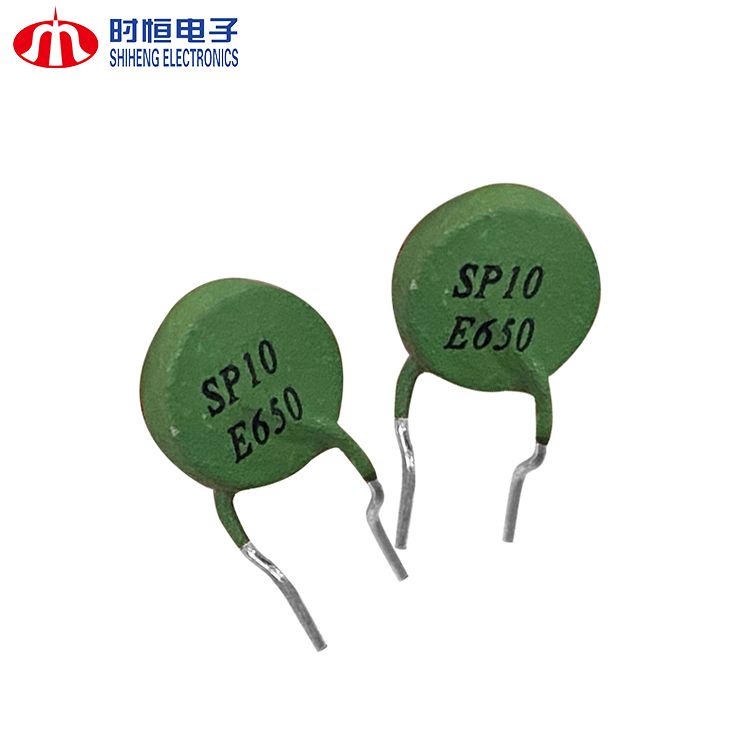ترمیستور PTC
Aug 21, 2024ترمیستور PTC قطعه ای است که مقدار مقاومت آن با رسیدن دما به مقدار معینی به سرعت افزایش می یابد. آنها معمولاً از مواد سرامیکی دوپ شده ساخته می شوند و در طیف گسترده ای از کاربردها که نیاز به حفاظت دما و محدود کردن جریان دارند استفاده می شوند.

ویژگی ها
- عملکرد خود بازیابی: هنگامی که جریان بیش از حد زیاد باشد یا دما خیلی بالا باشد، ترمیستور PTC به سرعت گرم می شود و مقدار مقاومت به میزان قابل توجهی افزایش می یابد و جریان جریان را محدود می کند و مدار را از آسیب محافظت می کند. هنگامی که خطا برطرف شد، دمای آن کاهش مییابد، مقاومت به مقدار کم باز میگردد و مدار کار عادی خود را از سر میگیرد.
- قابلیت اطمینان بالا: ترمیستور PTC می تواند عملکردهای حفاظتی را به طور مکرر بدون نیاز به تعویض یا تنظیم مجدد دستی انجام دهد.
- پاسخ سریع: ترمیستور PTC می تواند به سرعت به تغییرات دما پاسخ دهد و محافظت فوری را ارائه دهد.
- عمر طولانی: ترمیستورهای PTC از آنجایی که قطعات متحرک مکانیکی ندارد، عمر نسبتاً طولانی دارند و می توانند عملکرد پایدار خود را تحت شرایط جریان بیش از حد یا گرمای بیش از حد متعدد حفظ کنند.
اصل کار ترمیستور PTC بر اساس آن است مشخصه ضریب دمایی مثبت. هنگامی که جریان بیش از حد زیاد باشد یا دمای محیط بیش از حد بالا باشد، دمای ترمیستور PTC به سرعت افزایش مییابد و باعث میشود که مقدار مقاومت به شدت افزایش یابد و در نتیجه مقدار جریان عبوری محدود شده و مدار از آسیب محافظت میشود. هنگامی که دما به محدوده معینی کاهش می یابد، مقدار مقاومت به حالت اولیه خود باز می گردد و مدار دوباره به حالت عادی کار می کند.
ترمیستورهای PTC به طور گسترده در حفاظت از جریان بیش از حد در مدارها استفاده می شوند. آنها می توانند به طور خودکار جریان جریان را زمانی که جریان خیلی زیاد است محدود کنند تا از آسیب دیدن اجزای مدار به دلیل جریان بیش از حد جلوگیری کنند. کاربردهای رایج عبارتند از آداپتورهای برق، شارژرها، مدارهای کنترل موتور و غیره.
در برخی از کاربردهای کنترل دما، ترمیستورهای PTC به عنوان سنسور دما مورد استفاده قرار می گیرند. هنگامی که دما به مقدار تنظیم شده افزایش می یابد، مقدار مقاومت افزایش می یابد و سیگنال سیستم کنترل مدار را تحریک می کند تا تنظیم شود، مانند کنترل دمای بخاری، شروع فن و غیره.
ترمیستورهای PTC به عنوان اجزای حفاظت از گرمای بیش از حد در لوازم خانگی و تجهیزات صنعتی استفاده می شود. به عنوان مثال، در ترانسفورماتورها، تجهیزات روشنایی، موتورها و باتری ها، زمانی که دمای تجهیزات از محدوده ایمن فراتر رود، ترمیستور PTC به سرعت گرم می شود، مقدار مقاومت را افزایش می دهد، جریان را قطع می کند یا جریان را محدود می کند تا از تجهیزات جلوگیری کند. گرمای بیش از حد و آسیب.
در تجهیزات ارتباطی، ترمیستورهای PTC اغلب برای حفاظت از اضافه ولتاژ و حفاظت از جریان اضافه استفاده میشوند تا اطمینان حاصل شود که تجهیزات میتوانند تحت شرایط ولتاژ یا جریان ناپایدار به طور ایمن کار کنند. آنها به طور گسترده در خطوط تلفن، مودم ها، رابط های اترنت و غیره استفاده می شوند.
در زمینه الکترونیک خودرو، ترمیستورهای PTC در سیستم های مدیریت باتری، سیستم های یخ زدایی شیشه جلو و مدارهای روشنایی خودرو استفاده می شوند. آنها می توانند در لحظات بحرانی محافظت کنند، عمر مفید تجهیزات را افزایش دهند و از ثبات و ایمنی سیستم های الکترونیکی خودرو اطمینان حاصل کنند.
هنگام انتخاب یک ترمیستور PTC، باید عوامل زیر را در نظر بگیرید:
- جریان نامی: اطمینان حاصل کنید که ترمیستور PTC می تواند جریان نامی را در شرایط عملیاتی عادی بدون ایجاد حفاظت در برابر جریان اضافه عبور دهد.
- مقدار مقاومت: یک مقدار مقاومت اولیه مناسب را برای اطمینان از عملکرد صحیح مدار انتخاب کنید.
- زمان پاسخ: سرعت پاسخ مناسب را با توجه به الزامات برنامه انتخاب کنید.
- محدوده دمای عملیاتی: اطمینان حاصل کنید که ترمیستور PTC می تواند به طور معمول در محدوده دمای مورد انتظار کار کند.

ترمیستورهای PTC به دلیل وجود آنها به اجزای حفاظتی ضروری در مدارهای الکترونیکی مختلف تبدیل شده اند عملکرد خود بازیابی، قابلیت اطمینان و تطبیق پذیری بالا. با انتخاب و بکارگیری دقیق ترمیستورهای PTC می توان ایمنی و دوام مدار را تا حد زیادی بهبود بخشید و عملکرد پایدار تجهیزات را در محیط های پیچیده مختلف حفظ کرد.